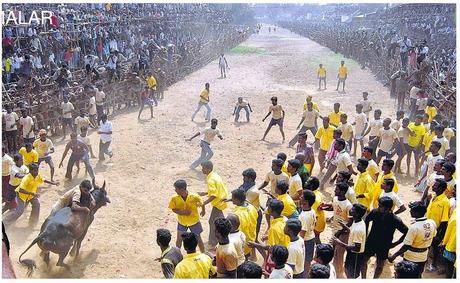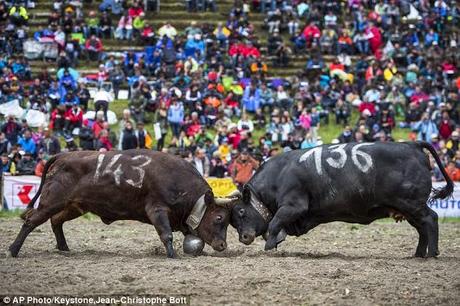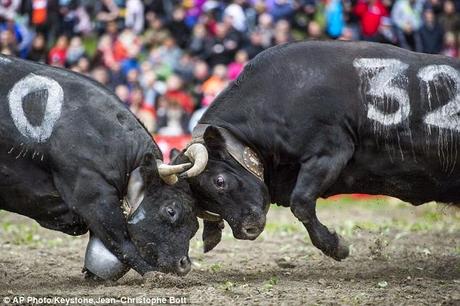 photo credit : Dinamalar daily
Down South in Tamil
Nadu, there is one which finds its place in Sangam literature and considered a
game of honor. Jallikattu (Aeru thazhuvuthal) is a bull taming sport
played in Tamilnadu; unlike its western cousin, the bull is seldom killed and
here the matadors do not use any weapons. Is it daredevilry ? a game ? or
torturing bulls or losing men trying to prove their valour ? what happens to
those who get killed ? and lose their limbs / senses ? - answers depend on perception. Now the Apex Court has banned the sport and
there are reports of bull owners in confused state as to what to do with the
decorated bulls.
In Spanish bull fighting, conducted in an arena
- the bull enters the ring, then an assistant waves a bright yellow and magenta
cape infront to anger it, the top
fighter called Matador and fighters Picadores weaken the bull by piercing
spears. The matador has a sword called
espada; the bull eventually drops dead.
There could be rules and variations, which we may not understand
much. One would be aghast to read “Toro
Jubilo festival” – and its gory details
: of Spanish bull-burning festival where baying crowd straps flaming wooden horns
to terrified animal. . . in the name of entertainment. The terrified animal has no escape route,
gets pinned to the floor, men strap wooden stakes doused in flammable chemicals
to its horns, and set it on fire with few more showing their bravery by tormenting the terrified
animal.
Cow fighting is a
traditional Swiss event, mostly in Valais, in which a cow fights another cow
~fortunately, it is not cow against humans or one animal killing the
other. Each year, the Swiss canton of
Valais hosts a series of cow fights known as combats de reines ("queen
fights"), which began in the 1920s and has drawn as many as 50,000
spectators in a year. The winner is called La Reine des Reines ("the queen
of queens") and increases dramatically in value. At the end of the year, a
grand final is held in Aproz, where the six best from seven districts do battle
in six weight categories.
Cows naturally
fight to determine dominance in the herd, and this is the behavior that is
exploited in cow fighting, using cows from the local Herens breed. With their
horns blunted, the fights are mainly a pushing contest. Any cow that backs down
from a fight is eliminated until one cow is left standing in the ring. It
sometimes happens that the cows in a fight refuse to engage in physical contact
with each other at all. Each fight can last up to 40 minutes.
A recent report in
MailOnline has these pictures of the cows clash stating that the Spanish fight bulls for sport, but in
Switzerland the cows are more likely to duke it out between themselves. The pictures are of the cows clashing at the
grand final of Switzerland's 'Combats de Reines' ('Battle of the Queens')
competition in Aproz, in the western Canton of Valais. The fighting cows are
drawn from the feisty Eringer breed, common in Valais, which are robust and
possess the singular characteristic of fighting among themselves for supremacy
within the herd. Comparatively small-bodied, brown and black-coated and with
curved white horns, the cows are these days bred specially for combat, rather
than milk or meat. Their horns are blunted before competition, so the fights
are mainly a contest of pushing and shoving, with losers determined by the
first cow to back down.
photo credit : Dinamalar daily
Down South in Tamil
Nadu, there is one which finds its place in Sangam literature and considered a
game of honor. Jallikattu (Aeru thazhuvuthal) is a bull taming sport
played in Tamilnadu; unlike its western cousin, the bull is seldom killed and
here the matadors do not use any weapons. Is it daredevilry ? a game ? or
torturing bulls or losing men trying to prove their valour ? what happens to
those who get killed ? and lose their limbs / senses ? - answers depend on perception. Now the Apex Court has banned the sport and
there are reports of bull owners in confused state as to what to do with the
decorated bulls.
In Spanish bull fighting, conducted in an arena
- the bull enters the ring, then an assistant waves a bright yellow and magenta
cape infront to anger it, the top
fighter called Matador and fighters Picadores weaken the bull by piercing
spears. The matador has a sword called
espada; the bull eventually drops dead.
There could be rules and variations, which we may not understand
much. One would be aghast to read “Toro
Jubilo festival” – and its gory details
: of Spanish bull-burning festival where baying crowd straps flaming wooden horns
to terrified animal. . . in the name of entertainment. The terrified animal has no escape route,
gets pinned to the floor, men strap wooden stakes doused in flammable chemicals
to its horns, and set it on fire with few more showing their bravery by tormenting the terrified
animal.
Cow fighting is a
traditional Swiss event, mostly in Valais, in which a cow fights another cow
~fortunately, it is not cow against humans or one animal killing the
other. Each year, the Swiss canton of
Valais hosts a series of cow fights known as combats de reines ("queen
fights"), which began in the 1920s and has drawn as many as 50,000
spectators in a year. The winner is called La Reine des Reines ("the queen
of queens") and increases dramatically in value. At the end of the year, a
grand final is held in Aproz, where the six best from seven districts do battle
in six weight categories.
Cows naturally
fight to determine dominance in the herd, and this is the behavior that is
exploited in cow fighting, using cows from the local Herens breed. With their
horns blunted, the fights are mainly a pushing contest. Any cow that backs down
from a fight is eliminated until one cow is left standing in the ring. It
sometimes happens that the cows in a fight refuse to engage in physical contact
with each other at all. Each fight can last up to 40 minutes.
A recent report in
MailOnline has these pictures of the cows clash stating that the Spanish fight bulls for sport, but in
Switzerland the cows are more likely to duke it out between themselves. The pictures are of the cows clashing at the
grand final of Switzerland's 'Combats de Reines' ('Battle of the Queens')
competition in Aproz, in the western Canton of Valais. The fighting cows are
drawn from the feisty Eringer breed, common in Valais, which are robust and
possess the singular characteristic of fighting among themselves for supremacy
within the herd. Comparatively small-bodied, brown and black-coated and with
curved white horns, the cows are these days bred specially for combat, rather
than milk or meat. Their horns are blunted before competition, so the fights
are mainly a contest of pushing and shoving, with losers determined by the
first cow to back down.
 The fighting cows,
despite their competitive instinct, can
sometimes be difficult to be provoked to combat due to their placid nature. Once
in the arena, they often need prodding, and even then they are sometimes more
interested in chewing the cud or exploring the daisies. If a cow refuses to
fight, she is eliminated. But other times all the cows will fight at once, in a
cacophony of mooing, stamping and locking horns. However, unlike the notorious
Spanish equivalent, blood is rarely spilt.
The fighting cows,
despite their competitive instinct, can
sometimes be difficult to be provoked to combat due to their placid nature. Once
in the arena, they often need prodding, and even then they are sometimes more
interested in chewing the cud or exploring the daisies. If a cow refuses to
fight, she is eliminated. But other times all the cows will fight at once, in a
cacophony of mooing, stamping and locking horns. However, unlike the notorious
Spanish equivalent, blood is rarely spilt.
 Winners are awarded
special cowbells and are crowned 'Queen' and the winner of the grand final
dubbed 'Queen of queens'. It's a coveted
prize; the pinnacle of a breeder's career. The achievement will not only earn
them local fame, but also secure a bumper fee of up to ten times the going rate
for any calf born to the winning cow. But despite the plaudits, and cash, up
for grabs, breeders admit its not really possible to train the cows how to
fight. All they can do is feed the animals and make sure they stay in good
shape.
'The rest is up to the cows -
fighting is in their blood. They love it,' says one.
With regards – S.
Sampathkumar
Winners are awarded
special cowbells and are crowned 'Queen' and the winner of the grand final
dubbed 'Queen of queens'. It's a coveted
prize; the pinnacle of a breeder's career. The achievement will not only earn
them local fame, but also secure a bumper fee of up to ten times the going rate
for any calf born to the winning cow. But despite the plaudits, and cash, up
for grabs, breeders admit its not really possible to train the cows how to
fight. All they can do is feed the animals and make sure they stay in good
shape.
'The rest is up to the cows -
fighting is in their blood. They love it,' says one.
With regards – S.
Sampathkumar
7th Apr 2015.

